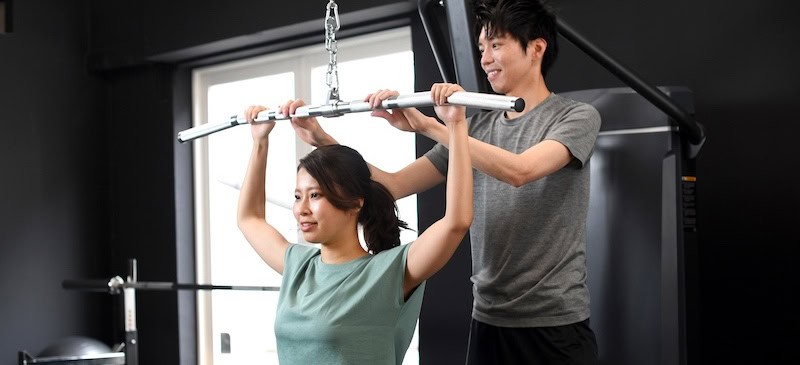Share this @internewscast.com

The latissimus dorsi muscles, commonly just called “the lats,” are the two biggest, broadest muscles in your back and, overall, one of the largest muscle groups in the whole body. As extensor muscles, the lats primarily have the job of helping lift the arms up as they lengthen and reach.
The lats are involved in other important functions beyond shoulder extension as well, including internal rotation of the torso and supporting core stability.
If you ever perform pulldowns, rows or lifting exercises for your shoulders using a resistance band or machine, chances are you’re already actively engaging and strengthening your lats. However, it’s common even for athletes to wind up developing tight latissimus dorsi muscles due to overuse or too little stretching, considered to be a major cause of both chronic shoulder and lower back pain.
For those who aren’t already performing strength-training moves, the lats and back are key areas to focus on. According to a report in the Journal of Orthopedics, “Because the latissimus dorsi connects the spine to the humerus, tightness in this muscle can manifest as either sub-optimal glenohumeral joint function (which leads to chronic shoulder pain) or tendinitis in the tendinous fasciae connecting the latissimus dorsi to the thoracic and lumbar spine.”
Considering the main function of the latissimus dorsi muscle is to assist in movement of the arms and protection of the spine, just about everyone can benefit from incorporating lat exercises into their day to help with improving balance, stability, range of motion and upper-body strength.
Ad

What is the latissimus dorsi?
The two latissimus dorsi muscles located in the center of the back are large, flat, generally strong muscles that are posterior (next to) to the trapezius muscles in the arms. They help connect the spine to the arms/upper extremities and support overall strength and stability of the whole trunk.
Since the lats are connected to the arms and upper back, they help hold the back upright, can play a part in preventing slouching and are used to maintain good posture.
The bottom of the lats extend to the tops of glutes, near the tailbone and lower back. Rotation or twisting movements in the back, plus raising the arms overhead, engage these muscles, making them important for upper-body strength, balance and general coordination.
Due to their size, strength and involvement in numerous motions of the body, exercising lats and being sure to stretch them enough are critical for maintaining range of motion and a healthy spine into older age.
What do the lats do?
There are three main muscle groups in the upper back: the trapezius, latissimus dorsi and erector spinae. Here’s an overview of the basic functions of the lats:
- Extension of the arms overhead, backward and downward. The lats are also commonly used when people walk and swing their arms from side to side, since they keep the back and core upright.
- Adduction (movement of the shoulder toward the midline) and transverse extension, which is also known as horizontal abduction. One of the most important jobs of the lats is allowing both arms to move toward the chest in an adduction movement.
- Medial (internal) rotation of the shoulder joint, which helps move the scapulae.
- Flexion when standing in an upright, extended position. This includes extension and lateral flexion of the lumbar spine, helping both lengthen and contract the back muscles with movements upward and down.
What are some of the key benefits of having strong lats? Based on how the lats support the back, arms and core, benefits of building strength and flexibility in this area include:
1. Maintaining strength in the shoulders, upper back and arms
You’re probably aware that the shoulders are one of the most utilized parts of the body, whether you’re an athlete or just someone going about your day-to-day routine. The shoulders are involved in movements like lifting the arms overhead, holding up weights or heavy objects, reaching in front of or behind you, and functions like catching, swinging, reaching and throwing.
The lats help support many movements of the shoulder muscles, joints and bones and are engaged during many common shoulder exercises, like planks, presses, lifts and pulls. If you already suffer from shoulder pain, for example, due to factors that degenerate connective tissue, such as older age, rotator cuff injury, osteoarthritis or overuse, studies suggest your symptoms and stiffness will likely only get worse if your lats/back become weaker.
2. Stability through the core, which is important for posture, balance and preventing falls
Both the lower back and the outer-middle part of your back (lateral back muscles) are part of your “core,” which means both must be strong and flexible to support you as you stand upright. Poor posture due to a weak back is linked to many different problems you might not even realize, such as headaches, respiratory problems, digestive issues, poor sleep and even tingling in the extremities.
A strong core, all the way from the front of your body (abs) wrapping around to your back, acts like a built-in girdle so you’re protected as you sit, stand and walk throughout the day.
Strengthening your lats will help keep your abdominal muscles pulled in tight, your shoulders pulled back, and your body from overall feeling tired or weak during the day. This keeps extra pressure off the lower back and is important for maintaining balance, especially as you age.
3. Help with sports or exercise performance (including twisting and rotating the torso/trunk)
As part of maintaining proper posture and preventing back pain, your lats help support the back during rotations, when lowering the hips down, or when twisting and bending over. Your back muscles work together with your obliques and abdominal muscles to support the spine and give you greater range of motion during all types of movements.
If you play sports such as tennis, golf, gymnastics, swimming, rowing, football, wrestling or basketball, or you work out by running and/or brisk walking, a strong core is essential. It’s also a great way to get rid of back fat.
Many of these activities involve lifting the arms, keeping the core stable, and having enough flexibility and balance to stay strong on your feet.

About the latissimus dorsi region
The latissimus dorsi connects to the teres major, fibres of the deltoid, long head of the triceps and several other stabilizing muscles. The teres major muscle is positioned above the latissimus dorsi muscle.
Ad

The lats insert into the tubercular groove at the front of the humerus and are partially covered by “the traps” (the upper back muscles) and connect to the deltoids (the front, side and rear of the shoulder).
Here’s an overview of the structure and region of the body surrounding the lats:
- Lats originate from the iliac crest located at the bottom of the spine by the hip bones.
- They connect to thoracolumbar fascia, tough membranes composed of three layers of tissue that cover the deep muscles beneath the back, which support the spine.
- Lats are supportive of inferior six thoracic vertebrae and inferior three or four ribs.
- They are supplied by the nerve roots that make up the long thoracic nerve, specifically those called C6, C7 and C8, which run through the trunk.
Strengthening the lats usually causes the elbows to bend (flexion) and involves engaging the shoulders, biceps and trapezius muscles.
One of the most commonly used antagonist muscle pairs in the human body is the pectorals/latissimus dorsi muscle pairing. These antagonist muscles have opposing functions, helping create full range of motion.
Agonists and antagonists usually exist on opposite sides near a joint, helping lower and lift. The deltoids and latissimus dorsi muscles lift and lower the entire arm at the shoulder joint.
Common injuries that affect the lats
Reasons that you might have weak or stressed lats include:
- Not lifting the arms overhead often enough, resulting in weak or stiff shoulders and arms
- Developing back pain that limits you from rotating, exercising, twisting and engaging the back muscles properly. Risk factors for back pain include history of back injuries or disorders, smoking or using tobacco, being overweight or obese, pregnancy, lack of sleep or sleeping in unsupportive positions, and having muscular tension due to anxiety/stress.
- Poor posture, which often causes low back pain and reduced range of motion
- Sitting for too long, such as at work for many hours of the day, which weakens the upper and mid-back
- Injuring the shoulders or low back, which prevents adduction, flexion and extension
- Although it doesn’t happen very often, lat tears have been reported related to sports activities like rock climbing, wrestling, golfing, bodybuilding, gymnastics, basketball and others.
What types of limitations or side effects can result from these lat-related injuries? While tearing or rupturing of the lats is rare, other related pains are common and include:
- Shoulder pain: The latissimus dorsi connects the spine to the humerus, so weakness or tightness in the lats/mid-back can cause pain in the shoulder joints and loss of upper-body functions. Sometimes this results in frozen shoulder or chronic tendonitis pain affecting the fasciae connective tissue.
- Back pain: The latissimus dorsi support the thoracic and lumbar regions of the spine, two areas that can develop pain due to factors like poor posture, forward head posture, a sedentary lifestyle (such as hunching over a desk all day) or due to impact and/or trauma. Back pain, whether mild or severe, is one of the most common complaints among adults and experienced at one point or another by the vast majority of people. In many cases of low back pain, the problem can usually be traced back to not having a strong enough core, which can be overcome through regular exercise plus stretching. Regularly performing lower back stretches, plus standing and moving more throughout the day, can do wonders to help prevent persistent back pain and injury.
- Instability and muscular imbalances: According to Men’s Journal, it’s not uncommon for men to have uneven lat strength, which contributes to loss of balance and pressure placed on the spine. Postural problems, including spinal abnormalities or injuries that stem down to the legs, along with muscular compensations or inactivity put added pressure on the back. People of all ages experience poor posture, but you’re especially at risk for dealing with side effects due to a weak back if you don’t rest enough between workouts or you’re sedentary, older than middle-aged or overweight. Exercises and strength training help reduce back pain by increasing flexibility, reducing inflammation, improving posture and reducing muscular compensations/weakness in the pelvis or hips.
Latissimus dorsi exercises and stretches
Even if you don’t belong to a gym or have little interest in attending some sort of strength-training or yoga class, you can practice simple bodyweight exercises and stretches at home in order to build lat strength and improve overall flexibility. Regularly performing several full-body movements and key stretches will help alleviate core weakness, stiffness in the lower back and muscular compensations that extend down through your hips and legs.
Do two to three of the exercises below, approximately one to two times per week, for major body parts like the lats. Aim for 10-15 reps, unless otherwise stated. Follow with the two stretch moves afterward.
Lat workouts are often best complemented by either a chest workout or a biceps workout.
Lat exercises
Lat pulldowns using a machine
Basic pulldown exercises using a machine at the gym are one of the best ways to engage the lats. You can either sit down on the machine’s bench or kneel on one or both knees (whichever helps you grasp the bar evenly above your head).
Pull down on the bar evenly to bring it down to your chest while keeping your back straight, and then raise the bar back to starting position.
Lat pulldowns using exercise bands
Utilizing an inexpensive resistance band at home or the gym is a great way to improve latissimus dorsi strength, as well as strength in your shoulders and core.
Start by anchoring a band to a stable high point, such as around a pole, and grabbing each end of the band using your hands. Begin with your arms straight and in front of your head, and then pull the arms back to bend your elbows as you bring your hands closer to the front of your chest.
Chin-ups
Using a pull-up bar, face and grab the bar with your palms overhead facing toward you. Your arms will be extended overhead in the starting position.
Keep your torso as straight as possible as you lift and pull your torso up until your head is around the level of the bar. From this contracted position, slowly lower your torso back to the starting position until your arms are fully extended overhead again.
Breath, and repeat for about five to 10 reps. If this is too difficult for you, try using a bench under your feet for some assistance or a pull-up assist if available.
Seated rows
Using a machine, sit with your knees bent so your shoulders are level with the machine handles and your back straight. With a handle in each hand, sit tall, and pull the handles toward you as you bend the elbows and move the shoulder blades together.
Return to starting position, and repeat.
Dumbbell one-arm rows
Stand near one side of a bench, and place your opposite knee and palm flat on the top of the bench. Keeping your arm on the bench straight and torso horizontal while you bend over, hold a dumbbell in your hanging hand.
Lift the dumbbell up toward your torso/side of your chest while bending the elbow, and then lower and repeat. Squeeze your belly in, and try to use strength and go slowly in both directions, rather than just relying on momentum.
Laying trunk lifts (aka “supermans”)
Laying down on the floor with your fingers interlaced behind your head, lift your chest and shoulders off the ground to engage your back. You can either keep your ankles/feet anchored to the floor by placing them under a bar or having someone support you, or lift the toes slightly.
Raise and lower about five to 10 times, going slowly and breathing. Be careful not to overextend or yank your neck.
Yoga chair pose (held squat)
Place your feet together so your big toes touch, and then lift your arms above your head, bringing the palms to face inward. Imagine a chair behind you that’s ready to catch your hips as you bend your knees and sink your pelvis down and backward.
Tuck your tailbone down, and keep your arms extended overhead while trying to maintain a straight back. Hold for five to 10 breaths as you lengthen on your inhales through your back and lower further down on your exhales.
Lat stretches
Standing overhead reach
Although they’re simple to stretch (you only need to extend your arms overhead), the lats are commonly neglected during most post-workout cooldowns.
To gently engage and stretch your lats, stand upright with your arms reaching above your head. You may want to slightly bend side to side, but go slowly to avoid yanking.
Hold your reach for 10 to 30 seconds at a time, continuing to lengthen the rib cage up and tucking the tailbone down.
Cat-cows or kneeling arm stretches
You can repeat the same type of arms-overhead movement as described above when kneeling on the floor on your shins/knees. Reach your fingertips overhead to touch the floor as you extend your shoulders and engage your back muscles.
Do this while keeping your hips either lifted or down near your heels. Hold the stretch for 10 to 30 seconds while breathing deeply to soften your muscles.
In yoga, this is known as “child’s pose” if your hips stay low to the floor or “puppy pose” if your hips stay lifted. You can also try other yoga poses by staying kneeled down on your shins while breathing through “cat-cow” movements.
Do these as you stretch the back in one direction upward by lifting your chest and tailbone, then down toward the ground as you reverse.
Precautions
If the lats or other parts of your back start to feel pain during your workout or pain increases afterward and lasts more than two to three days, back off from exercising the area, and rest for at least several days. Begin exercises slowly, and don’t overdo stretches.
If you feel throbbing, stiffness or notice swelling extending up to the upper body, avoid resistance training involving the painful areas, and consider seeing a doctor or physical therapist for advice.
Final thoughts
- The latissimus dorsi (aka “the lats”) are large muscles located in the upper-mid back that help support movement of the arms. Functions of the lats include extension of the arms and shoulders overhead or backward and downward, plus core/trunk stability.
- The lats can become weak or stressed due to being overweight, sedentary, overtraining with lack of stretching or degenerative issues like arthritis. This can cause chronic low back pain or shoulder pain in some cases.
- Exercises for the lats include pulldowns, presses or pulls, supermans, and dumbbell lifts.















